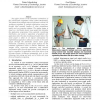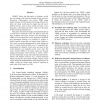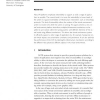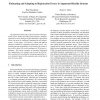VR
2002
IEEE
14 years 4 months ago
2002
IEEE
In virtual environments, perceived egocentric distances are consistently underestimated when compared to the same distance judgments in the real world. The research presented in t...
VR
2002
IEEE
14 years 4 months ago
2002
IEEE
The availability of inexpensive and powerful graphics cards as well as fast Internet connections make Networked Virtual Environments viable for millions of users and many new appl...
VR
2002
IEEE
14 years 4 months ago
2002
IEEE
In this paper, we describe simple techniques for object group manipulation, an important operation in user interaction with a Virtual Environment. All presented manipulation techn...
VR
2002
IEEE
14 years 4 months ago
2002
IEEE
This paper focuses on the distributed architecture of the collaborative augmented reality system Studierstube. The system allows multiple users to experience a shared 3D workspace...
VR
2002
IEEE
14 years 4 months ago
2002
IEEE
VRML97 allows the description of dynamic worlds that can change with both the passage of time, and user interaction. Unfortunately, the current VRML usage model prevents its full ...
VR
2002
IEEE
14 years 4 months ago
2002
IEEE
Many VR platforms emphasize extensibility to support as wide a range of applications as possible. The current trend is to move this extensibility to lower levels of the system to ...
VR
2002
IEEE
14 years 4 months ago
2002
IEEE
This paper presents a unified user interface technology, using 3D interaction techniques, constructive solid geometry, and a glove based menuing system, known as TinmithHand, to s...
VR
2002
IEEE
14 years 4 months ago
2002
IEEE
We have developed a method for recognizing and tracking known three-dimensional objects in scene images captured from a user’s viewpoint. The method uses multiple color histogra...
VR
2002
IEEE
14 years 4 months ago
2002
IEEE
All augmented reality (AR) systems must deal with registration errors. While most AR systems attempt to minimize registration errors through careful calibration, registration erro...
VR
2002
IEEE
14 years 4 months ago
2002
IEEE
Interaction with medical volume data has often been difficult due to the large memory and computational power required. By taking advantage of current high-end graphics hardware, ...




